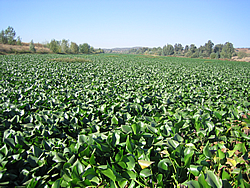

European and Mediterranean Plant Protection Organization
Council of Europe – Bern Convention
Ministero de Agricultura, Pesca y Alimentación de España
Ministero de Medio Ambiante de España

EPPO/CoE Workshop - How to manage invasive alien plants?
The case studies of Eichhornia crassipes and Eichhornia azurea
2008-06-02/04, Mérida, Spain
The workshop on Eichhornia crassipes gathered 40 participants from Czech Republic, Croatia, Estonia, France, Germany, Morocco, the Netherlands, Portugal, South Africa, Slovenia, Spain, Turkey, and Zambia.
Eichhornia crassipes is a floating aquatic plant originating from South America sold for ornamental purposes. The plant is recognized as one of the most invasive alien plants in the world. It has huge detrimental economic impacts: it is a threat to agriculture, plant health, environment, public safety, recreation activities, water quality and quantity and human health.
More than 15 papers and posters were presented during the Workshop on the biology, distribution, pathways, and impacts of the plant. Emphasis was given to management measures taken against E. crassipes in Africa (South Africa, Zambia) and in the EPPO region. In Spain, the removal of nearly 200,000 tonnes of the plant from the Guadiana River (along 75 km) cost 14,680,000 euros from 2005 to 2008. In Portugal, the management actions carried out by the Municipality of Agueda cost 278,000 euros from December 2006 to May 2008.

All pictures by Ángel Hurtado
Nogales, Confederación Hidrográfica del Guadiana (ES)
During this Workshop, a Pest Risk Analysis was performed and it concluded that the species has the potential to establish and cause detrimental effects in the whole Mediterranean Basin. It was concluded that E. crassipes should be proposed for regulation as a quarantine pest (EPPO A2 List) in 2008, and that an EPPO Standard on National Regulatory Control Measures should be prepared.
Additionally, the Council of Europe will publish a recommendation to invite its Member Countries:
- to prohibit the sale, movement, possession and planting of the plant,
- to monitor the species and share information with other countries,
- to draft a national action plan to manage the plant.
Presentations
Biology of the species
Plant biology and other issues that relate to the management of water hyacinth: a global perspective with focus on Europe
Mic Julien, CSIRO Montpellier, FranceBiology and reproduction of the water hyacinth in the River Guadiana, (Badajoz) Spain
Water hyacinth at the seed banks of the Guadiana River (Spain)
Water hyacinth systematics
Trinidad Ruiz Téllez, Elsa Martín de Rodrigo López, Adolfo Muñoz Rodríguez, Juan Manuel Sánchez Guzman, Gloria Lorenzo Granado,Eva Albano Pérez, GIC-Uex , Grupo de Investigación en Biología de la Conservación, Universidad de Extremadura, Spain
Pathways of entry of the plant, potential for establishment and spread of the plant
Pathways of entry and potential distribution of Eichhornia crassipes under climate change scenario
Sarah Brunel, EPPO
Potential for establishment and spread of the plant
Predictive models of the Eichhornia crassipes’ potential distribution in the Guadiana River (Spain)
Elsa Martín de Rodrigo, Ricardo Morán López, Trinidad Ruiz Téllez, Juan Manuel Sánchez Guzmán, Grupo de Investigación en Biología de la Conservación, Universidad de Extremadura, Spain.
Impacts of the plant
Environmental and Socio-economic impacts of Eichornnia crassipes in the Victoria Falls/Musi-oa-Tunya Pilot Site, Livingstone, Zambia
Michael Nang’alelwa, UNEP/GEF IAS Project, Zambia
Management measures
The water hyacinth (Eichhornia crassipes) in the Guadiana area. Experiences of management
Nicolás Cifuentes, Confederación Hidrográfica del GuadianaIntegrated control of water hyacinth in Africa
Martin Hill, Rhodes University, South AfricaEichhornia crassipes control in the largest Portuguese natural freshwater lagoon – a case of success
Célia M Laranjeira, Municipality of Águeda, PortugalBiological control of water hyacinth – the South African experience
Julie Coetzee, Rhodes University, South AfricaLegislative framework on the water hyacinth invasion in the River Guadiana (Badajoz) Spain
Bettina Perales Casildo, Trinidad Ruiz Téllez, Juan Manuel Sánchez Guzmán, GIC- Uex, Grupo de Investigación en Biología de la Conservación, Universidad de Extremadura, Spain.Waterways maintenance equipment
Jose Coimero, Cabena, Portugal
Communication actions
The invasion of water hyacinth (Eichhornia crassipes) in the Victoria Falls World Heritage Site: communicating beyond the boundaries
Michael Nang’alelwa, UNEP/GEF IAS Project, Zambia
Invasive alien plants in specific countries
Invasive alien plants in the coasts of Turkey
Irfan Uysal, Ministry of Environment and Forestry, Turkey
POSTERS
Distribution and management of Eichhornia crassipes in the Valencian region
Pena et al.Biology and reproduction of the water hyacinth in the River Guadiana, (Badajoz) Spain
Tellez et al.Water hyacinth at the seed banks of the Guadiana River (Spain)
Tellez et al.
Water hyacinth systematics
Tellez et al.Predictive models of Eichhornia crassipes' potential distribution in the Guadiana river
Martin de Rodrigo et al.
